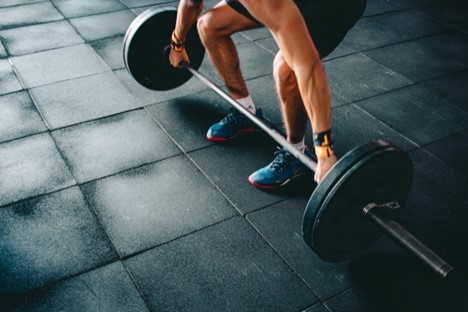We all have weaknesses. No one is perfect. But if we can identify what our particular weaknesses are then we have a chance to work on them and even turn them into strengths. As we get older we experience a lot of changes – mental, emotional, social, spiritual and physical. Some of the changes are beneficial and turn into strengths (like the wisdom gained from life experience or the increased focus on faith) and some become weaknesses. Physical changes you may experience as you get older are partly due to the aging process itself and partly due to the accumulative effects of your lifestyle choices. These changes may include decreased muscle strength, gait problems, poor balance, decreased flexibility and joint problems. Knowing exactly what areas you are deficient in is key to starting an exercise program that is just right for you.
If we can identify what our particular weaknesses are then we have a chance to work on them and even turn them into strengths.
Whenever I train a client I always start with a complete health history assessment and a battery of functional fitness assessments. The proper assessments can help identify these areas of weakness that need to be prioritized in an exercise program. But you don’t have to find a PhD in Exercise Science to test your functional fitness. There are plenty of quick and easy tests that you can do right at home or at your gym with the help of a friend or trainer. Here are two tests below which have been developed specifically for mature adults and that we use consistently with our clients. Norms have been developed for each of these tests based on age and gender. So your score reflects how you compare to others your age and gender.
Sitting Test: 30 Second Chair Stand
The purpose of this test is to assess lower-body strength in a functional manner.
The test can be performed with minimal equipment. All that is needed is a stopwatch and a straight-back or folding chair with a seat height of 17 inches. The chair should be placed against the wall to prevent slipping during the test.
Sit in the middle of the chair with back straight, feet flat on the floor and arms crossed at the wrists and held against the chest (making an “X”). Your partner will time the test with the stopwatch. Upon the command “Ready, Set, Go” they will start the time and you should rise to a full stand and then return to a fully seated position. Continue standing up and sitting down until your partner tells you that 30 seconds has lapsed. Complete as many full stands as possible in the 30 seconds. Before testing, you can practice one or two chair stands with proper form to get warmed up.
Your score is the number of stands you can complete in 30 seconds. If you are more than halfway up at the end of 30 seconds, it counts as a full stand. If you cannot perform even one chair stand without using your hands then your score is zero. However, you can perform the test by using your arms to push off your legs or the chair, or use a cane or walker if necessary. This will provide a baseline for assessing improvement or decline over time. Only one trial should be administered.
Tips:
- Elbows should stay tight to the body the whole time. Avoid swinging your arms away from your body.
- Brace the chair against the wall or have someone hold it steady during the test.
- Your body weight should shift fully to the chair seat when you sit down.
Scoring:
|
|
Women |
Men |
||||||
|
% Rank |
60-64 |
65-69 |
70-74 |
75-79 |
60-64 |
65-69 |
70-74 |
75-79 |
|
90 |
20 |
18 |
18 |
17 |
22 |
21 |
20 |
20 |
|
80 |
18 |
16 |
16 |
16 |
20 |
19 |
18 |
18 |
|
70 |
17 |
15 |
15 |
14 |
19 |
18 |
17 |
16 |
|
60 |
16 |
14 |
14 |
13 |
17 |
16 |
16 |
15 |
|
50 |
15 |
14 |
13 |
12 |
16 |
15 |
14 |
14 |
|
40 |
14 |
13 |
12 |
12 |
15 |
14 |
13 |
13 |
|
30 |
12 |
12 |
11 |
11 |
14 |
13 |
12 |
12 |
|
20 |
11 |
11 |
10 |
9 |
13 |
11 |
11 |
10 |
|
10 |
9 |
9 |
8 |
8 |
11 |
9 |
9 |
8 |
Walking Test: 8’ Up and Go
The purpose of this test is to assess agility and dynamic balance.
The only equipment needed is a stopwatch, a straight-back or folding chair with a seat height of 17 inches, a tape measure and a cone (or empty 2-liter bottle). Place the chair against the wall facing a cone placed exactly 8 feet away (measured from the front edge of the chair to the farthest edge of the cone).
Sit in the middle of the chair with back straight, feet flat on the floor and hands on the thighs. One foot should be placed slightly in front of the other foot with the torso slightly leaning forward (in the “ready” position). Upon the command “Ready, Set, Go” they will start the time and you will get up from the chair, walk as quickly as possible around either side of the cone, and sit back down in the chair. The timer should start on the word “go” whether or not you have started to move and the timer should stop at the instant your bottom makes contact with the chair.
Practice it once at slow speed. During the test walk do it “as quickly and safely as possible”. Perform the test twice and use the fastest time (to the tenth of a second) for your score. If needed, a cane or walker can be used for this test, but scores should not be compared to the norms.
Tips:
- Place the chair against a wall to keep it secured.
- There is a high risk of falling during this test so conduct it in an open area free from obstructions.
- Walk, do not run, during the test.
Scoring:
|
|
Women |
Men |
|||||||
|
% Rank |
60-64 |
65-69 |
70-74 |
75-79 |
60-64 |
65-69 |
70-74 |
75-79 |
|
|
90 |
3.7 |
4.1 |
4.0 |
4.3 |
3.0 |
3.6 |
3.6 |
3.5 |
|
|
80 |
4.2 |
4.6 |
4.7 |
5.0 |
3.6 |
4.1 |
4.2 |
4.3 |
|
|
70 |
4.6 |
5.0 |
5.2 |
5.5 |
4.0 |
4.5 |
4.6 |
4.9 |
|
|
60 |
4.9 |
5.3 |
5.6 |
5.9 |
4.4 |
4.8 |
5.0 |
5.4 |
|
|
50 |
5.2 |
5.6 |
6.0 |
6.3 |
4.7 |
5.1 |
5.3 |
5.9 |
|
|
40 |
5.5 |
5.9 |
6.4 |
6.7 |
5.0 |
5.4 |
5.6 |
6.4 |
|
|
30 |
5.8 |
6.2 |
6.8 |
7.1 |
5.4 |
5.7 |
6.0 |
6.9 |
|
|
20 |
6.2 |
6.6 |
7.3 |
7.6 |
5.8 |
6.1 |
6.4 |
7.5 |
|
|
10 |
6.7 |
7.1 |
8.0 |
8.3 |
6.4 |
6.6 |
7.0 |
8.3 |
|
If you score lower than the 70th percentile on either of these tests then you need to specifically work on strength and agility, respectively. If you score lower than the 50th percentile then it is even more imperative that you focus on these two areas.
These tests were designed for adults over the age of 60. If you are younger than 60 years old then your standard should be to score higher than the 90th percentile for the 60-64 age category. If you do not then that indicates that you need exercise specifically to improve these areas. Here are some exercises to help get you started:
Strength Exercise Examples:
- Chair Stand
- Squat
- Lunge
- Step-Up
- Calf/Toe Raise
Gait and Agility Exercise Examples:
- Walk Heel to Toe
- High Knees
- Straight Leg March
- Side Step (over small object)
- Forward and Backward Step (over small object)
- Crossover Walk (cross one front in front of the other as you walk)
Don’t let your weaknesses hold you back from living a fulfilling life at any age. Draw on your faith, practice these strength, gait and agility exercises and you’ll not only know your weaknesses, you’ll discover the strength God has given you for your older years.










